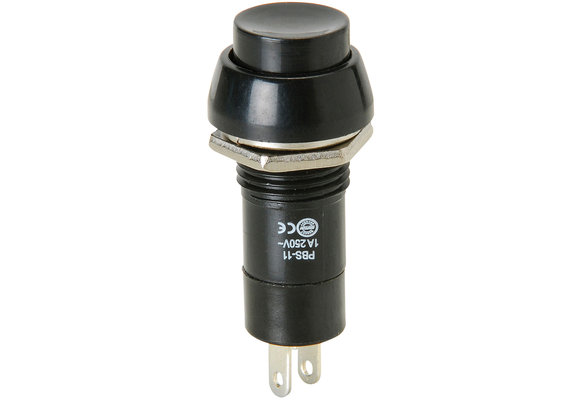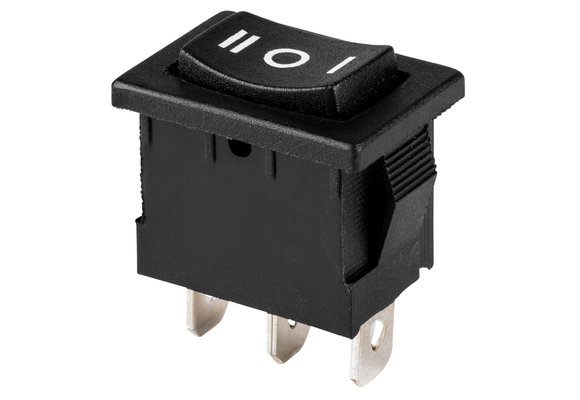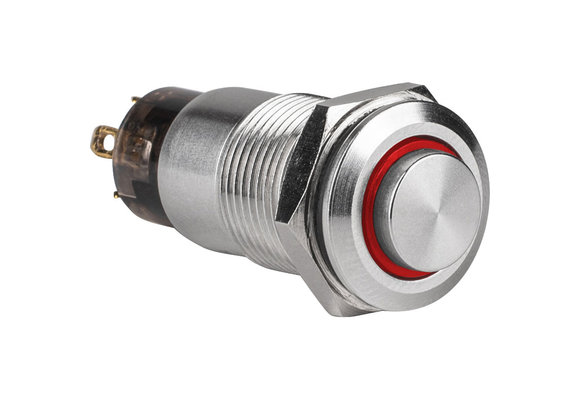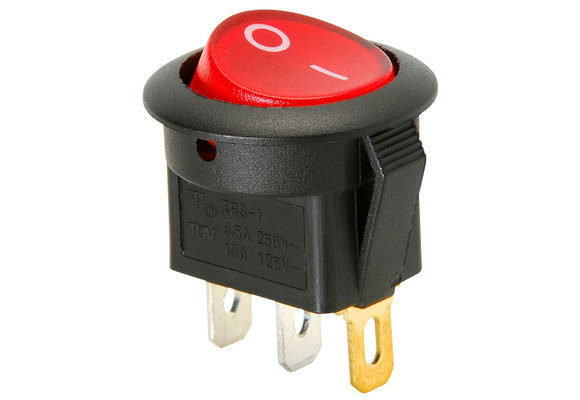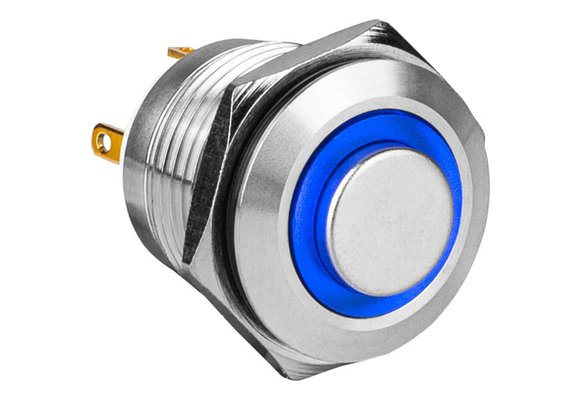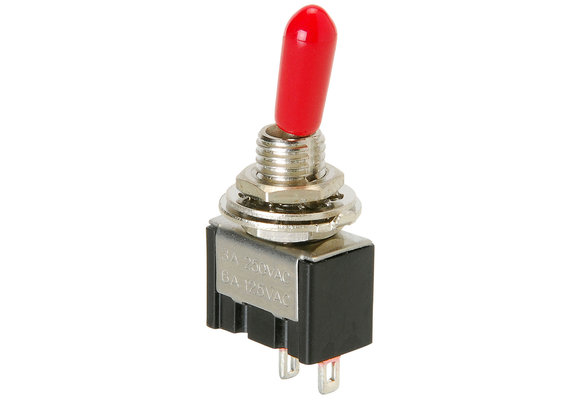In electronics and electrical engineering, a switch is used to make or break a contact. The resting position is always represented by the first state, or switching state. The final position, which can be the starting position (again) or another one, is always represented by the remaining switching positions. Here at SoundImports, you can buy various kinds of switches, among others from our premium-brand Monacor.
What is the difference between an on-off switch and an NC-NO system?
There are two switch systems – the on-off system and the NC-NO system. When the switch is closed at rest, it is called 'on' in the on-off system. It's 'off' if it's open at rest. The switch can now be set to one of three states: on, off, or empty (unconnected pin/common). Static states and flipping states are the two types of states. They can also be dynamic or spring-back, meaning they stay in the 'on' or 'off' position for a limited time. When the switch is closed, the idle state is 'usually closed (NC)' or break contact, whereas when it is open, it is 'normally open (NO)' or make contact in the NC-NO system. When inspecting a rocker switch, the handle direction reveals which contacts are open or closed.
What are the different types of switches?
There are four different types of switches:
- SPST (Single Pole Single Throw)
- SPDT (Single Pole Double Throw)
- DPST (Double Pole, Single Throw)
- DPDT (Double Pole Double Throw)
The SPST switch is a simple ON/OFF switch that is used to connect or disconnect two terminals. This switch is the source of power for the owl circuit. The SPST switch is also known as a toggle switch. This switch has only one input and output.
The SPDT switch is a three-terminal switch with one terminal serving as an input and the other two serving as outputs. It connects two terminals, one of which is a mutual terminal and uses the COM terminal instead of the other terminals in the SPDT switch. The SPDT switch is most commonly used in a three-way circuit to turn on/off light from two different locations, such as the top and bottom of a stairwell.
The DPST switch has two poles, which implies it has two identical switches next to one other. This switch is controlled by a single toggle, which implies that one push controls two discrete circuits at the same time. This switch has four terminals, two inputs and two o/ps, and is used to turn two circuits ON/OFF. The primary use of this switch is to control a 240V device in which both supply voltages must be turned on, but the unbiased wire may be connected at all times. When this switch is switched on, the current flows via two circuits, and when it is turned off, the current stops flowing.
The DPDT switch is the same as two SPDT switches, which means two distinct circuits with two inputs and two outputs each. The number of routes is controlled by the switch position, and each contact can be routed from the two contacts. When in ON-ON or ON-OFF-ON mode, they function similarly to two independent SPDT switches controlled by a comparable actuator. Only two loads can be active at the same time. Any application that requires an open and closed wiring system can benefit from a DPDT switch.

 Home audio
Home audio  Audio components
Audio components  Crossover components
Crossover components  Test & measurement
Test & measurement  DIY kits
DIY kits  Accessories
Accessories  New products
New products  Speakers
Speakers Amplifiers
Amplifiers DAC converters
DAC converters DSP modules
DSP modules Turntables
Turntables Streamers
Streamers Woofers
Woofers Tweeters
Tweeters Exciters
Exciters Bass shakers
Bass shakers Plate amplifiers
Plate amplifiers Amplifier modules
Amplifier modules Single board computers
Single board computers Assembled crossovers
Assembled crossovers Printed Circuit Boards (PCB)
Printed Circuit Boards (PCB) Capacitors
Capacitors Resistors
Resistors Coils
Coils Circuit Breakers
Circuit Breakers Crossover tools
Crossover tools Screw terminals
Screw terminals Acoustic measurements
Acoustic measurements Electric measurements
Electric measurements Sound level meters
Sound level meters DIY amplifier kits
DIY amplifier kits DIY component packs
DIY component packs DIY speaker kit
DIY speaker kit DIY subwoofer kits
DIY subwoofer kits DIY bluetooth speaker
DIY bluetooth speaker DIY electronics kits
DIY electronics kits Binding posts
Binding posts Cabinet Hardware
Cabinet Hardware Cables
Cables Connectors
Connectors Speaker cabinets
Speaker cabinets Electromechanics
Electromechanics Power supplies
Power supplies Speaker repair
Speaker repair Workshop & tools
Workshop & tools Amplifier accessories
Amplifier accessories Stands & mounts
Stands & mounts Gift voucher
Gift voucher Books
Books New products
New products









 Speakers
Speakers Amplifiers
Amplifiers DAC converters
DAC converters DSP modules
DSP modules Turntables
Turntables Streamers
Streamers Woofers
Woofers Tweeters
Tweeters Exciters
Exciters Bass shakers
Bass shakers Plate amplifiers
Plate amplifiers Amplifier modules
Amplifier modules Single board computers
Single board computers Assembled crossovers
Assembled crossovers Printed Circuit Boards (PCB)
Printed Circuit Boards (PCB) Capacitors
Capacitors Resistors
Resistors Coils
Coils Circuit Breakers
Circuit Breakers Crossover tools
Crossover tools Screw terminals
Screw terminals Acoustic measurements
Acoustic measurements Electric measurements
Electric measurements Sound level meters
Sound level meters DIY amplifier kits
DIY amplifier kits DIY component packs
DIY component packs DIY speaker kit
DIY speaker kit DIY subwoofer kits
DIY subwoofer kits DIY bluetooth speaker
DIY bluetooth speaker DIY electronics kits
DIY electronics kits Binding posts
Binding posts Cabinet Hardware
Cabinet Hardware Cables
Cables Connectors
Connectors Speaker cabinets
Speaker cabinets Electromechanics
Electromechanics Power supplies
Power supplies Speaker repair
Speaker repair Workshop & tools
Workshop & tools Amplifier accessories
Amplifier accessories Stands & mounts
Stands & mounts Gift voucher
Gift voucher Books
Books New products
New products
